
New, centrally acting dopaminergic agents with an improved oral bioavailability [2004]
.pdf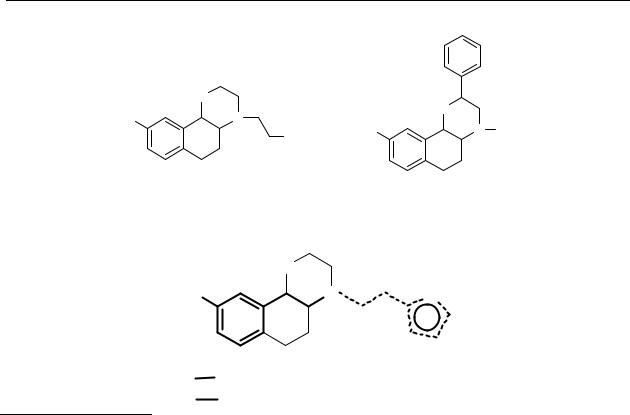
Thienylethylamines as possible dopamine pharmacophore
2
1
O
HO |
4 |
|
O |
N |
HO |
N nPr |
|
9 |
R |
||
|
|
|
|
27a. R = CH3 (PHNO, trans) |
|
28 (trans) |
|
b. |
= phenyl (trans) |
|
|
c. |
= 2-thienyl (trans) |
|
|
|
O |
|
|
HO |
N |
|
S |
Pharmacophore 1
Pharmacophore 2
Chart 2.1 Chemical structures of trans-9-hydroxy-N-n-propyl-2,3,4a,5,6,10b-hexahydro-4H- naphth[1,2b][1,4]oxazine (PHNO, 27a), trans-9-hydroxy-4-(2-phenylethyl)- 2,3,4a,5,6,10b-hexahydro-4H-naphth[1,2b][1,4]oxazine (27b), trans-9-hydroxy-4- (2-thienylethyl)-2,3,4a,5,6,10b-hexahydro-4H-naphth[1,2b][1,4]oxazine (27c), trans-9- hydroxy-2-N-n-propyl-2,3,4a,5,6,10b-hexahydro-4H-naphth[1,2b][1,4]oxazine (28).
For a more extensive exploitation of this theory, we synthesised some derivatives of the potent dopamine D2/D3 agonist PHNO 27a.206,207 According to the Wikström/Seiler modification of McDermed’s model N-substituents larger than n-propyl should give compounds inactive at the dopamine D2/D3 receptors, while the steric requirements for an R group on the 2- position should be less critical.
The in vitro pharmacology data of the naphthoxazines (Table 2.1) confirmed that an N-substituent should not be larger than an n-propyl, and that there is more structural freedom for a 2-substituent. However, a thienylethyl substituent on the nitrogen (1c) gave a compound with a significantly higher affinity for the dopamine D3 receptor than the phenylethyl analogue 27b. We hypothesised that the dopamine receptor pharmacophore of compound 27c is the thienylethylamine moiety (pharmacophore 2, chart 2.1) and not the 3-OH-phenylethylamine moiety (pharmacophore 1, chart 2.1). To test this hypothesis the thienylethylamines 29 and 30 were synthesised and tested in vitro.
31

Chapter 2
|
|
N |
|
N |
|
S |
S |
S |
|
|
S |
|||
|
|
|
|
|
|
29 |
|
30 |
|
|
|
|
|
|
Chart 2.2 |
Chemical structures of |
N-n-propyl-(3-thiophen-2-yl-ethyl)-thiophen-3-ylethyl-amine |
||
(29), N-n-propyl-(2-thiophen-2-yl-ethyl)-thiophen-3-ylethyl-amine (30).
The in vitro pharmacology of compounds 29 and 30 (Table 2.1) showed that the thienylethylamine moiety could behave as a pharmacophore at the dopamine receptor.
It has been known for a long time that the 2-aminotetralin (2-amino-1,2,3,4- tetrahydronaphthalene) structure is pharmacologically important. Initially, 2-aminotetralins were characterised by their sympathomimetic action, causing mydriasis, contraction of the uterus, changes in blood pressure and respiration, and increased intestinal motility in test animals.202-204
The 2-aminotetralin system has proved to be a valuable structural base for dopamine receptor, serotonin receptor and adrenoceptor ligands, as well as for compounds that interact with melatonin receptors.208,209
Some of these compounds have been studied by several research groups to elucidate their structure activity relationship for dopamine receptors.98,100,101,201,205,210-212 Initially, these studies identified S-(–)-5-hydroxy-2-(N,N-di- n-propylamino)tetralin (S-(–)-5-OH-DPAT, S-(–)- 9) as the most potent monohydroxy 2-aminotetralin.98,100,205 Later S-(–)-5-hydroxy-2-(N- n-propyl-N-2- thienylethylamino)tetralin (S-(–)-N-0437, S-(–)- 31) was found to be an even more potent dopamine receptor agonist.201 Moreover, R-(+)-7-hydroxy-2-(N,N-di-n-propylamino)tetralin (R-(+)-7-OH-DPAT, R-(+)-10) was later shown to have preference for the dopamine D3 receptor subtype.79,213
32
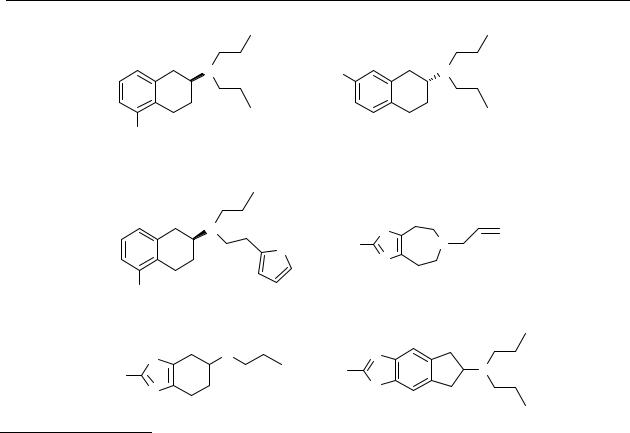
Thienylethylamines as possible dopamine pharmacophore
N |
HO |
N |
OH |
|
|
S-(–)-9 |
|
R-(+)-10 |
N |
|
|
S |
|
S |
H2N |
N |
|
|
|
N |
OH S-(–)-31 |
|
|
32 |
|
H |
|
N |
S |
N |
|
|
|
H2N |
N |
|
H2N |
|
||
|
|
S |
|
N |
|
|
|
|
|
|
|
19 |
|
|
33 |
Chart 2.3 Chemical structures of S-(–)-5-hydroxy-2-(N,N-di- n-propylamino)tetralin (S-(–)-5-OH- DPAT, S-(–)- 9), R-(+)-7-hydroxy-2-(N,N-di-n-propylamino)tetralin (R-(+)-7-OH- DPAT, R-(+)-10), S-(–)-5-hydroxy-2-(N- n-propyl-N-2-thienylethylamino)tetralin (S-(–)-N-0437, S-(–)- 31), 5,6,7,8-tetrahydro-6-(2-propenyl)-4H-thiazolo[4,5-d]azepin-2- amine (BHT920, 32), pramipexole (19) and 6-amino-2-(N,N-di-n-propylamino)- thiazolo[4,5-f]indan (GMC1111, 33).
Their low oral bioavailability and their short duration of action have limited the clinical utility of catechol and phenol-containing drugs. The catechol and phenol rings provide optimal sites for glucuronidation. Thus, for many years, emphasis has been focused on the identification of bioisosteric replacements for catechols and phenols. The idea that neither catecholic nor phenolic hydroxyl groups are an absolute requirement for potent dopamine receptor activity was
183
presented by Andén et al., who showed that the aminothiazolazepine derivative BHT920 (32) is a dopamine autoreceptor agonist, as well as an α2-adrenoceptor agonist. Pramipexole (19), a benzothiazole analogue of the 2-aminotetralins, was found to be a potent dopamine receptor agonist with both dopamine D2 and D3 receptor stimulating properties. It is presently on the market for the treatment of Parkinson’s disease.146,154,155 Another example of an analogue with an aminothiazole moiety is GMC1111 (33), which possesses affinity for the dopamine D2 and D3 receptor, and also inhibits lipid peroxidation.214
33
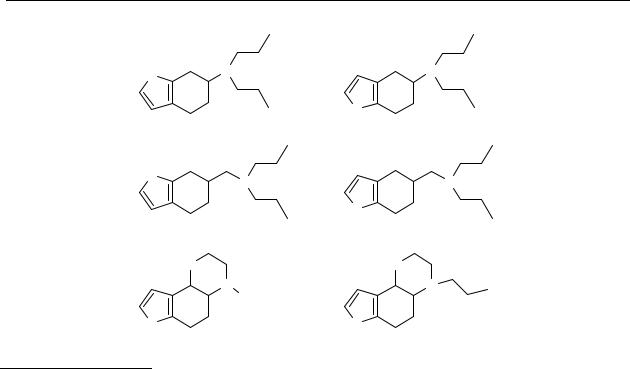
Chapter 2
S |
N |
N |
|
|
|
|
|
S |
|
34 |
35 |
S |
N |
N |
|
||
|
|
S |
|
36 |
37 |
|
O |
O |
|
N |
N |
|
H |
|
S |
|
S |
|
38 |
39 |
Chart 2.4 Chemical structures of 6-(N,N-di-n-propyl)amino-4,5,6,7-tetrahydrobenzo[b]thiophene (34), 5-(N,N-di-n-propyl)amino-4,5,6,7-tetrahydrobenzo[b]thiophene (35), 6- (N,N-di-n- propyl)aminomethyl-4,5,6,7-tetrahydro-benzo[b]thiophene (36), 5- (N,N-di-n- propyl)aminomethyl-4,5,6,7-tetrahydro-benzo[b]thiophene (37), trans-2,3,4a,5,6,9b- hexahydro-4H-thianaphth[4,5e][1,4]oxazine (38), trans-N-n-propyl-2,3,4a,5,6,9b- hexahydro-4H-thianaphth[4,5e][1,4]oxazine (39).
Since it was found that the thienylethylamine moiety might act as a dopamine receptor pharmacophore, we tested whether a thiophene moiety may act as a bioisostere for a phenol in 2-aminotetralins and hexahydronaphthoxazines. Therefore, thiophene analogues of the 2-aminotetralins and hexahydronaphthoxazines, 34-39 were synthesised. All the compounds synthesised were tested in vitro for their affinity at dopamine D2L and D3 receptors. The derivatives with interesting properties were further investigated for their in vivo dopamine receptor activity and bioavailability using the microdialysis technique in freely moving rats.215
2.2Chemistry
The trans N-arylalkyl substituted hexahydronaphthoxazines 27b and c were synthesised from trans-9-methoxy secondary amine 40 via N-alkylation with the appropriate arylethyl halide or by reductive alkylation. The trans-9-methoxy secondary amine 40 was prepared by using known methods.206,216,217 The phenols were achieved through ether cleavage with BBr3 under N2
(Scheme 2.1).
34
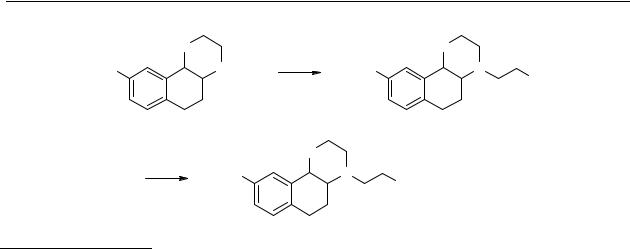
Thienylethylamines as possible dopamine pharmacophore
|
O |
|
|
|
O |
MeO |
|
NH |
a |
MeO |
N |
|
|
||||
|
|
|
|
|
Ar |
|
trans-40 |
|
|
|
trans-41a,b |
|
|
|
|
O |
|
|
b |
HO |
|
N |
|
|
|
|
Ar |
||
|
|
|
|
|
trans-27b,c
Scheme 2.1 Reagents: (a) C6H5CH2CH2Br, K2CO3, DMF or 2-thienyl acetic acid, (CH3)3N.BH3,
xylene; (b) BBr3, CH2Cl2.
The synthesis of 2-phenyl-N-n-propylnaphthoxazine 28 is outlined in Scheme 2.2. The racemic trans-aminoalcohol 42 was acylated with 2-chloro-2-phenylacetyl chloride to afford a mixture of diastereomeric trans-amidoalcohols 43. Cyclisation of the chloroacetamide 43 was achieved with NaOH in isopropanol, affording the mixture of trans-lactams 44a, b with the 2-phenyl ring in equatorial or in axial position. The 2-(axial)phenyl trans-lactam and the 2-(equatorial)phenyl-trans-lactam could be separated by column chromatography. Theoretically the morpholine-ring can exist in two conformations namely a pseudo chair or boat conformation. The phenyl-ring can be adjusted in a pseudo-axial and pseudo-equatorial position. The morpholine ring exists probably most of the time in a chair conformation since this is energetically the most favourable conformation, but it is possible that the conformation changes to the boat-conformation. When the morpholine ring exists in a chair conformation with the phenyl-ring in the axial position there is an interaction in space between the protons on C10b and C15/C19. The other epimer with the phenyl-ring in the equatorial position shows an interaction in space between the protons on C10b and C2. The NOESY-experiments showed that the fast eluting compound has an interaction between the protons on C10b and C15/C19, so this is the compound with the phenyl in the axial position. The last eluting compound shows an interaction between the protons on C10b and C2, indicating that the compound has the phenylring in the equatorial position. The 2-equatorial-phenyl isomer was used for the next reaction. After reduction of the amide with BH3.Me2S complex, the final step was demethylation, which was achieved by applying BBr3, giving the final product 28.
35
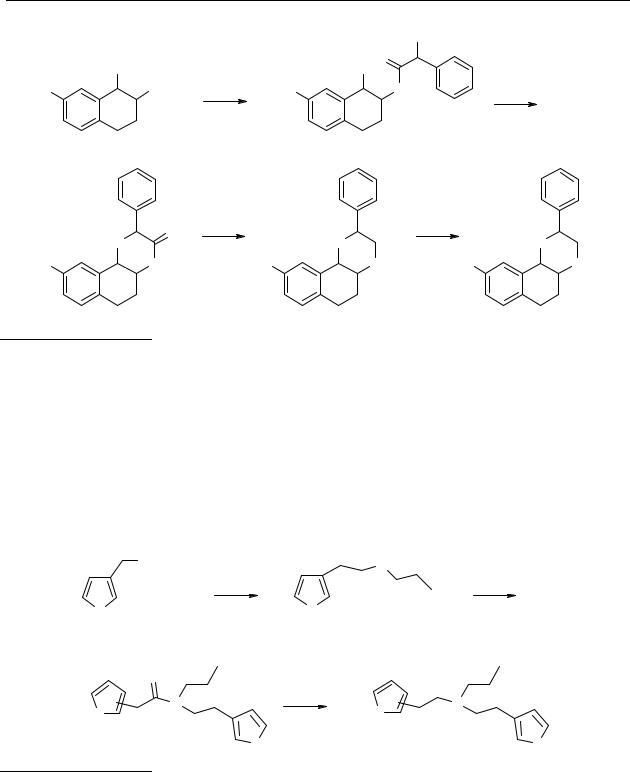
Chapter 2
|
|
|
|
Cl |
|
|
OH |
|
|
|
O |
|
|
|
|
|
OH |
|
|
|
MeO |
NHC3H7 |
a |
MeO |
NC3H7 |
|
b |
42 |
|
|
|
43 |
|
|
15 |
19 |
|
|
|
|
|
|
O |
c |
|
|
d |
|
O |
|
|
O |
|
O |
|
2 |
|
|
|
|||
MeO |
NC3H7 |
|
MeO |
NC3H7 |
HO |
NC3H7 |
10b |
|
|
|
|
|
|
44a,b |
|
|
|
45 |
|
28 |
Scheme 2.2 Reagents: (a) PhCHClCOCl, NaOH, CH2Cl2; (b) NaOH, i-PrOH; (c) BH3.Me2S, THF;
(d) BBr3, CH2Cl2.
The thienylethylamines 29 and 30 were synthesised according to Scheme 2.3. The secondary amine 47 was acylated with 2- or 3-thienylacetylchloride. As a result of the rotation around a binding with a partial double bond character the aliphatic protons and the aliphatic carbon atoms of 48 and 49 were according to the 1H- and 13C-NMR spectra chemically non-
equivalent. The resulting amides were reduced with BH3.Me2S complex.
COCl |
|
|
H |
|
|
|
N |
|
|
|
|
|
|
|
|
a, b |
|
c |
|
S |
|
|
S |
|
46 |
|
|
47 |
|
O |
|
|
|
|
N |
|
b |
N |
|
|
|
|
||
S |
|
|
S |
|
48 2-thienyl, 3-thienyl |
S |
|
29 2-thienyl, 3-thienyl |
S |
49 3-thienyl, 3-thienyl |
|
|
30 3-thienyl, 3-thienyl |
|
Scheme 2.3 Reagents: (a) C3H7NH2, CH2Cl2; (b) BH3.Me2S, THF; (c) 2- or 3-thienylacetyl chloride,
CH2Cl2, Et3N.
The synthesis of the tetrahydrobenzo[b]thiophenes is outlined in Scheme 2.4. A Grignardreaction of 50 with ClMgCH2SiMe3 followed by quaternisation with methyl iodide gave the 3-(trimethylammoniummethyl)-2-(trimethylsilylmethyl)thiophene 52, which is the precursor of
36
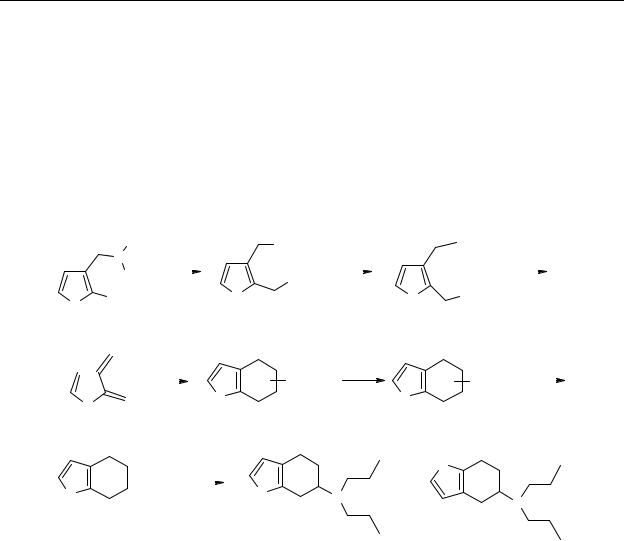
Thienylethylamines as possible dopamine pharmacophore
2,3-dimethylene-2,3-dihydrothiophene.218 Treatment of 52 with n-tetrabutylammonium fluoride (TBAF) leads to the formation of 2,3-dimethylene-2,3-dihydrothiophene, which is an unstable intermediate. This intermediate was captured in a Diels-Alder [4 + 2] cycloaddition reaction with methyl acrylate as the dienophile. We did not succeed in the separation of the mixture of regioisomers obtained. Hydrolysis of this mixture of esters gave the carboxylic acids 54a, b in good yield. A Curtius rearrangement gave the mixture of amines 55a, b.218 Only after conversion into the tertiary amines 34 and 35 was it possible to separate the mixture of regioisomers on a SiO2 column.
|
|
|
|
|
|
|
Me |
|
|
|
|
|
|
NMe |
|
|
|
N+Me3I- |
||||||||||
|
|
|
|
|
N |
a |
|
|
|
|
2 |
|
b |
|
|
|
c |
|
||||||||||
|
|
|
|
|
|
|
|
|
|
|
|
|
||||||||||||||||
|
|
|
|
|
|
|
Me |
|
|
|
|
|
|
|
|
|||||||||||||
|
|
|
|
|
|
|
|
|
|
|
|
S |
|
SiMe3 |
|
|
S |
SiMe3 |
||||||||||
|
S |
|
Br |
|
|
|
|
|
|
|
|
|
|
|||||||||||||||
|
50 |
|
|
|
|
|
|
|
|
|
|
51 |
|
|
|
|
|
52 |
|
|
|
|
|
|||||
|
|
|
|
|
|
|
|
|
|
|
|
|
|
|
|
|
|
|
|
|
|
|
|
|||||
|
|
|
|
|
|
|
|
|
|
|
|
|
|
|
3 |
4 |
|
|
|
|
|
|
|
|
|
|
||
|
|
|
|
|
|
|
|
|
|
|
|
|
|
|
|
|
|
|
|
|
|
|
|
|
||||
|
|
|
|
|
|
|
|
|
|
|
|
|
|
|
|
|
|
5 |
|
d |
|
|
|
e |
||||
|
|
|
|
|
|
|
|
|
|
|
|
|
|
|
|
|
|
|
CO2CH3 |
|
|
|
||||||
|
|
|
|
|
|
|
|
|
|
|
|
|
|
|
|
|
|
|
|
|
|
|||||||
|
|
|
|
|
|
|
|
|
|
|
|
|
|
|
2 |
S |
6 |
|
|
S |
COOH |
|||||||
|
|
|
|
S |
|
|
|
|
|
|
|
|
|
|
|
|
|
|
|
|
|
|
||||||
|
|
|
|
|
|
|
|
|
|
|
|
|
7 |
|
|
|
|
|
|
|
|
|
||||||
|
|
|
|
|
|
|
|
|
|
|
|
|
|
|
|
|
|
|
|
|
|
|||||||
|
|
|
|
|
|
|
|
|
|
|
|
|
|
|
|
|
53a,b |
|
|
|
|
54a,b |
|
|
|
|
|
|
|
|
|
|
|
|
|
|
|
|
|
|
|
|
|
|
|
|
|
|
|
|
|
|
|
|
|||
|
|
|
|
|
|
|
|
|
NH2 |
|
|
|
|
f,g |
|
|
|
|
|
S |
|
|
|
|
|
|||
|
|
|
|
|
|
|
|
|
|
|
|
|
|
|
|
|
|
|
|
|
|
|
|
|||||
|
S |
|
|
|
|
|
|
|
|
|
|
|
S |
|
N |
|
|
|
|
N |
||||||||
|
|
|
|
|
|
|
|
|
|
|
|
|||||||||||||||||
|
|
|
|
|
|
|
|
|
|
|
|
|
|
|
|
|
|
|
|
|||||||||
|
|
|
|
|
|
|
|
|
|
|
|
|
|
|
|
|
|
|
|
|
|
|
|
|
||||
|
|
|
|
55a,b |
|
|
|
|
|
|
34 |
|
|
|
|
35 |
|
|
|
|
||||||||
|
|
|
|
|
|
|
|
|
|
|
|
|
|
|
|
|
|
|
|
|
|
|
|
|
|
|
||
|
|
|
|
|
|
|
||||||||||||||||||||||
Scheme 2.4 Reagents: |
(a) |
|
ClMgCH2SiMe3, Ni(PPh3)2Cl2, |
Et2O; |
(b) CH3I, CH3CN; (c) |
|||||||||||||||||||||||
|
|
|
|
CH2=CHCO2CH3, TBAF, CH3CN; (d) NaOH; (e) 1) DPPA, Et3N, dioxane; 2) HCl, |
||||||||||||||||||||||||
|
|
|
|
dioxane, |
120 |
|
°C; (f) |
C 3H7I, |
K2CO3, DMF; |
(g) SiO2 |
column chromatography, |
|||||||||||||||||
|
|
|
|
EtOAc:Hexane = 1:9. |
|
|
|
|
|
|
|
|
|
|
|
|||||||||||||
The aminomethyltetrahydrobenzo[b]thiophenes (36 and 37) were synthesised from the corresponding carboxylic acids (54a and b) in three steps by standard chemistry (Scheme 2.5). The two isomers could be separated on a SiO2 column after conversion to the tertiary amines.
37
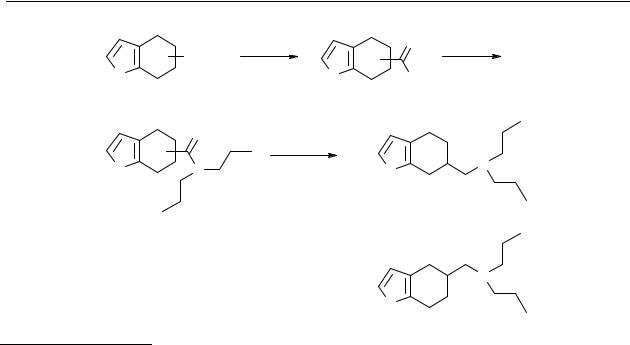
Chapter 2
|
a |
|
|
O |
b |
|
COOH |
|
|
|
|
S |
|
S |
|
Cl |
|
54a,b |
|
56a,b |
|
|
|
|
|
|
|
|
|
|
O |
c, d |
|
|
|
|
|
|
|
|
|
S |
N |
|
S |
|
N |
|
|
|
|||
57a,b |
|
|
|
36 |
|
|
|
|
|
|
N
S
37
Scheme 2.5 Reagents: (a) (COCl)2, CH2Cl2; (b) (C3H7)2NH, Et3N, CH2Cl2; (c) LiALH4, THF; (d)
SiO2 column chromatography, CH2Cl2: MeOH = 20:1.
The hexahydrothianaphthoxazines 38 and 39 were synthesised from the commercially available ketone 58, which was readily converted into the tosyloxime 60 in two steps. Neber rearrangement of 60 with potassium tert-butoxide afforded the desired amino-ketone 61. The amino ketone 61 was readily acylated with chloroacetyl chloride. Reduction of the ketochloroacetamide 62 with sodium borohydride gave only the trans isomer. The proton on C1 gave a doublet at δ 4.6 ppm with a coupling constant of 7.2 Hz indicating a di-axial coupling. The ciscompound would have a couplings constant of about 3.5 Hz.
The cyclization of the alcohol-chloroacetamide 63 by means of 50 % aqueous NaOHsolution in isopropanol at room temperature gave satisfactory yields of the lactam 64, which was reduced with LiAlH4 to the oxazine 38. The reduction took place in a low yield. Alkylation of the amine 38 with propyl iodide in DMF afforded the tertiary amine 39 in a good yield.
38
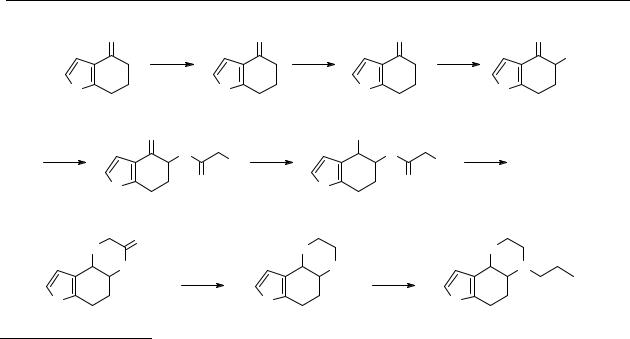
Thienylethylamines as possible dopamine pharmacophore
O |
|
NOH |
|
NOTs |
c,d |
O |
|
a |
b |
|
|
NH2 |
|
|
|
|
|
|||
S |
S |
|
S |
|
|
S |
58 |
|
59 |
|
60 |
|
61 |
O |
H |
|
OH |
H |
|
|
e |
f |
|
|
g |
||
N |
|
N |
Cl |
|||
|
Cl |
|
|
|
|
|
S |
O |
S |
|
O |
|
|
|
|
|
|
|
||
62 |
|
|
63 |
|
|
|
O |
|
O |
|
|
|
O |
O |
|
|
|
|
||
NH |
h |
|
NH |
i |
|
N |
|
|
|
|
|
||
S |
|
S |
|
|
S |
|
trans-64 |
|
trans-38 |
|
|
|
trans-39 |
Scheme 2.6 Reagents: (a) NH2OH.HCl; (b) TsCl; (c) t-BuOK/ETOH; (d) HCl/H2O; (e) ClCH2COCl, NaOH, CH2Cl2; (f ) NaBH4; (g) NaOH; (h) LiAlH4; (i) C3H7I, DMF, K2CO3.
2.3Results and Discussion
The structural requirements for the N-substituents of dopaminergic 7- and 9-hydroxylated octahydrobenzo[f]quinolines (OHB[f]Q) and related compounds have been described previously.101 On the basis of in vivo biochemical and behavioural data it was demonstrated that the nitrogen should be substituted with maximal an n-propyl group for optimal dopamine receptor activity. Larger N-substituents, (e.g. n-butyl) for the 9-hydroxy-OHB[f]Qs gave a dramatic reduction in potency of these compounds. The Ki values shown in Table 2.1 for the N-substituted 9-hydroxy-hexahydronaphthoxazines (9-OH-HNO) 27b and 28 are in full agreement with the models of McDermed and Wikström. 98,101 According to these models there is space available for a 2-substituent. Interestingly, however, the dopamine D 3 receptor affinity of 27c (Ki = 83 nM) showed that this compound does not fit these receptor models. This has led us to hypothesise that it is the thienylethylamine moiety of 27c, which confers dopamine D3 receptor properties to this compound. In the binding model for the dopamine receptors described by Miller et al., the protonated nitrogen of the ligand interacts with the receptor. 219 With the development of molecular biological techniques and the cloning of the dopamine receptors, the amino acid sequence of the different receptors were determined which lead to the assumption that the protonated nitrogen of ligands interacts with Asp 114 (D2) or Asp 110 (D3) in transmembrane domain 3 through a reinforced ionic bond (for review see ref. 21). In the hydroxylated 2-aminotetralins and OHB[f]Qs an additional hydrogen bond is formed from the phenolic hydrogen of the ligands to the Ser 193 (D2) or Ser 192 (D3) in transmembrane domain 5.115 If a thiophene ring utilises the same interaction points as the phenol, it may be speculated
39

Chapter 2
that the sulfur atom in the thienylethyl substituent may form a hydrogen bond with the hydroxyl moiety of a Ser residue. Sulfur can only act as a hydrogen bond acceptor and consequently this weaker interaction may provide an explanation for the lower affinity for the dopamine D3 receptor of compound 27c, as compared to compound 27a.220-222 Two alternative explanations for the diminished affinity are I) the non-optimal distance between the hydrogen bond forming moieties on the aromatic site and the nitrogen, II) alternative interaction points in the receptor for these essential atoms in a dopamine receptor.
Table 2.1 Receptor binding data of various dopamine receptor ligands.
|
|
Ki (nM)a |
Compound |
D2L |
D3 |
|
[3H]N-0437 |
[3H]Spiperone |
(+)-PHNO ((+)-27a) |
6.24 |
0.21 |
(±)-27b |
>3676 |
1566 |
(±)-27c |
3676 |
83 |
(±)-28 |
375 |
12 |
29 |
1080 |
117 |
30 |
439 |
108 |
34 |
27 |
28 |
35 |
20 |
40 |
36 |
3107b |
60 |
37 |
2037 |
247 |
38 |
>4780b |
3000 |
39 |
630b |
240 |
(–)-5-OH-DPAT (9) 223 |
14 |
0.54 |
(+)-7-OH-DPAT (10)223 |
34 |
0.57 |
(±)-N-0437 (31)223 |
0.06 |
4.0 |
Footnotes: a Ki values are means of three separate experiments; the results of which did not vary more than 25%. b [3H]NPA was used as radiolabeled ligand.
To prove the assumption whether the thienylethylamine moiety can act as a pharmacophore, we synthesised compounds 29 and 30, possessing only the thienylethylamine moieties. These compounds possess low to moderate affinity for the dopamine D3 receptor, but confirmed our assumption that a thienylethylamine moiety can act as a non-optimal pharmacophore at the dopamine D3 receptor.
40
